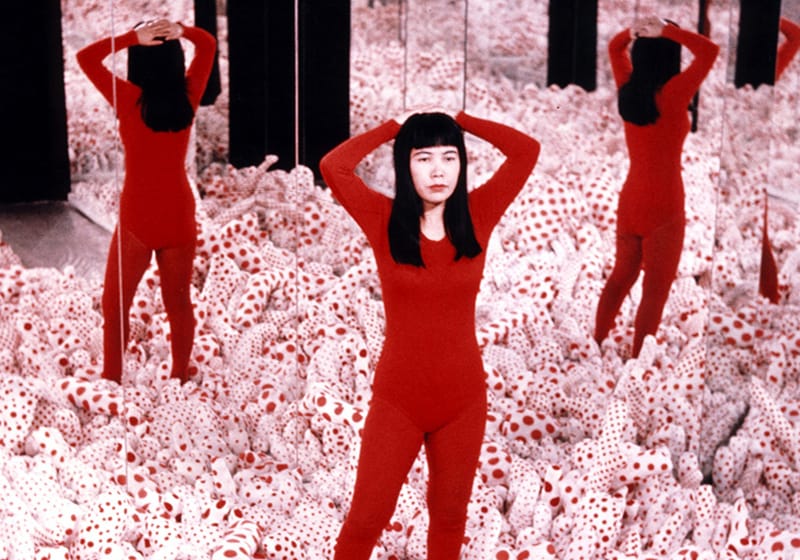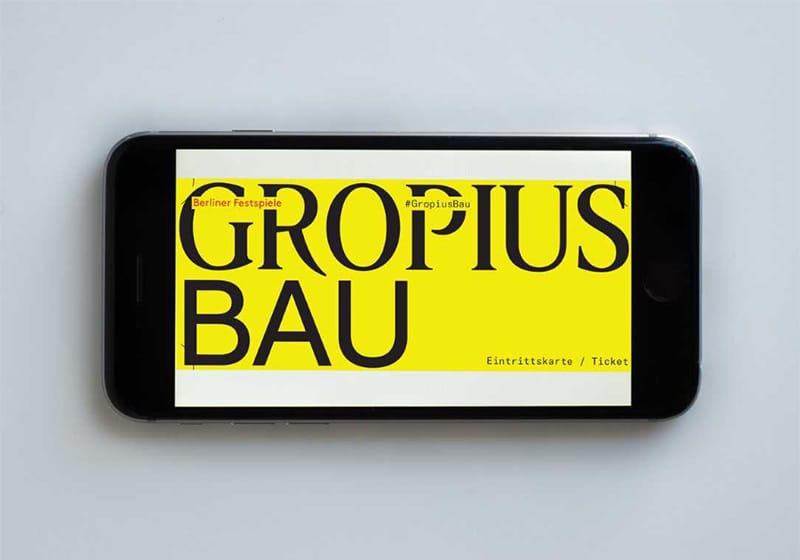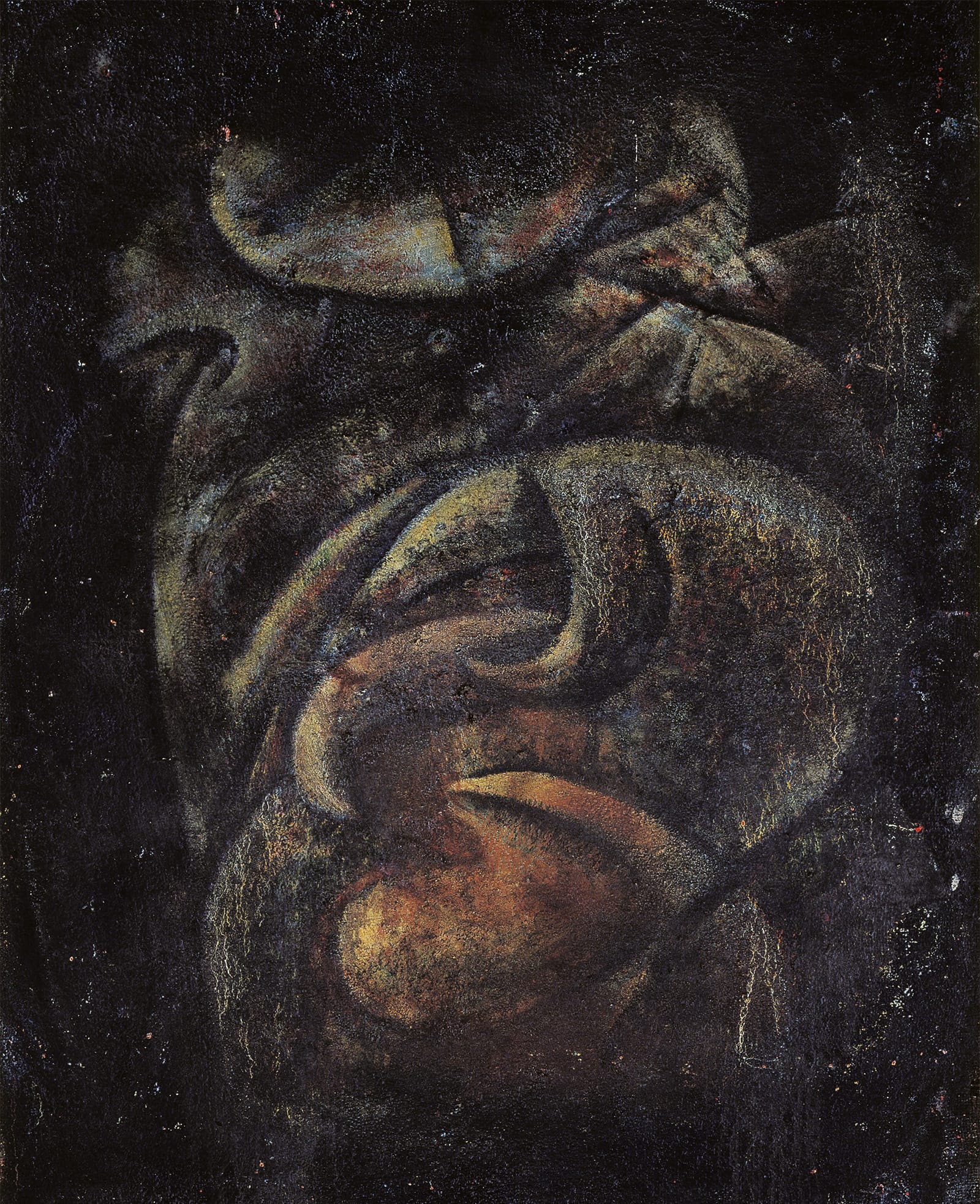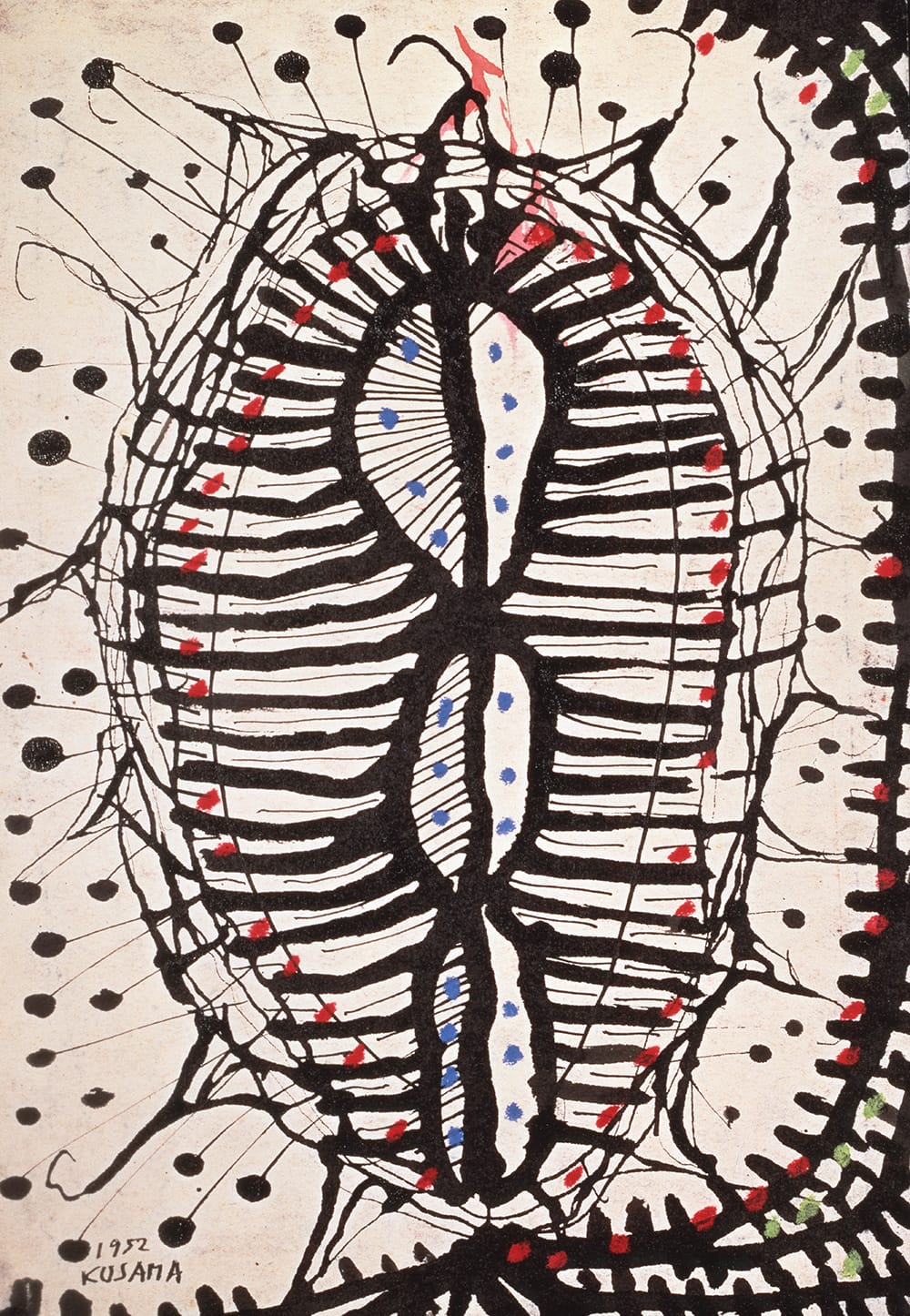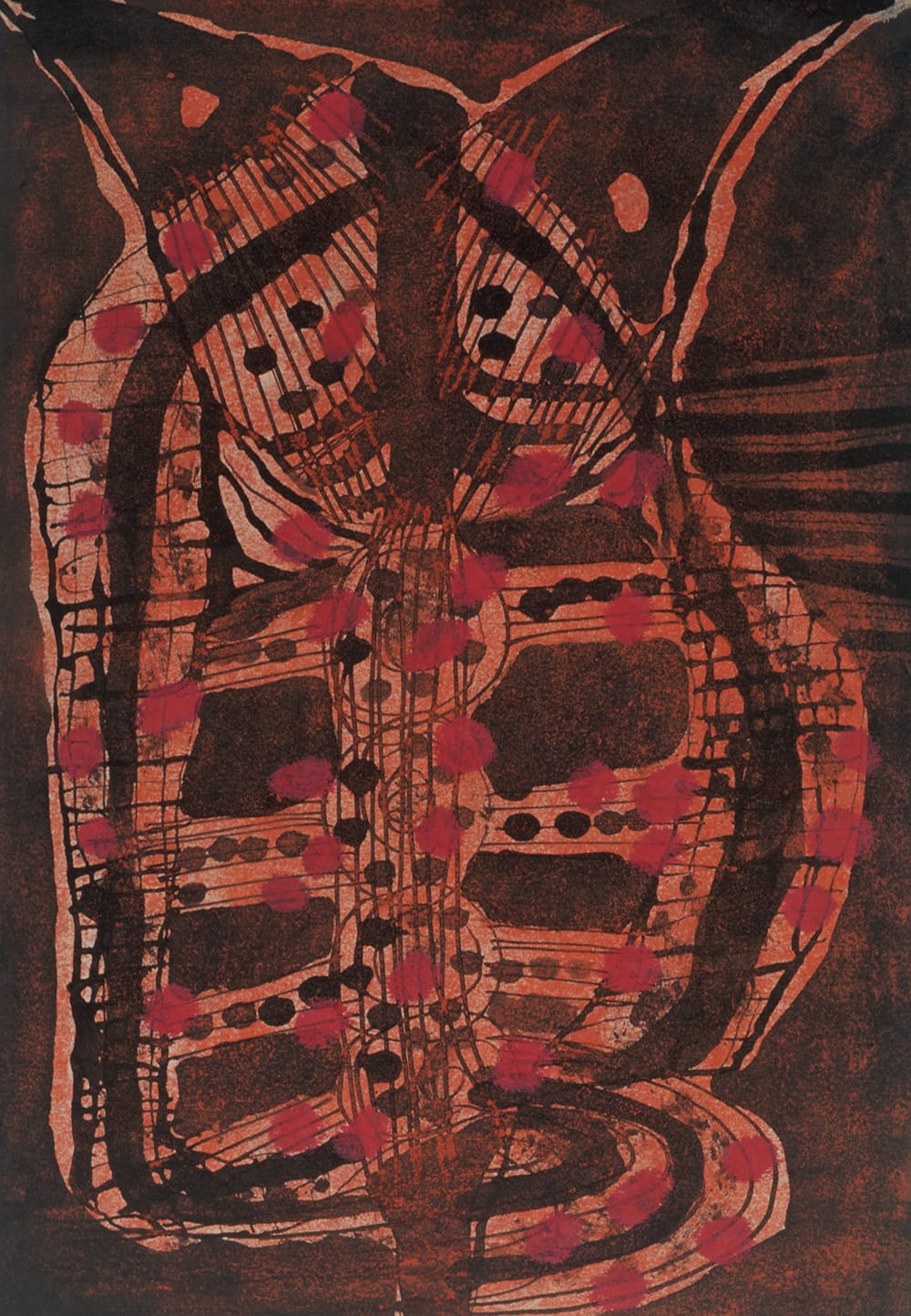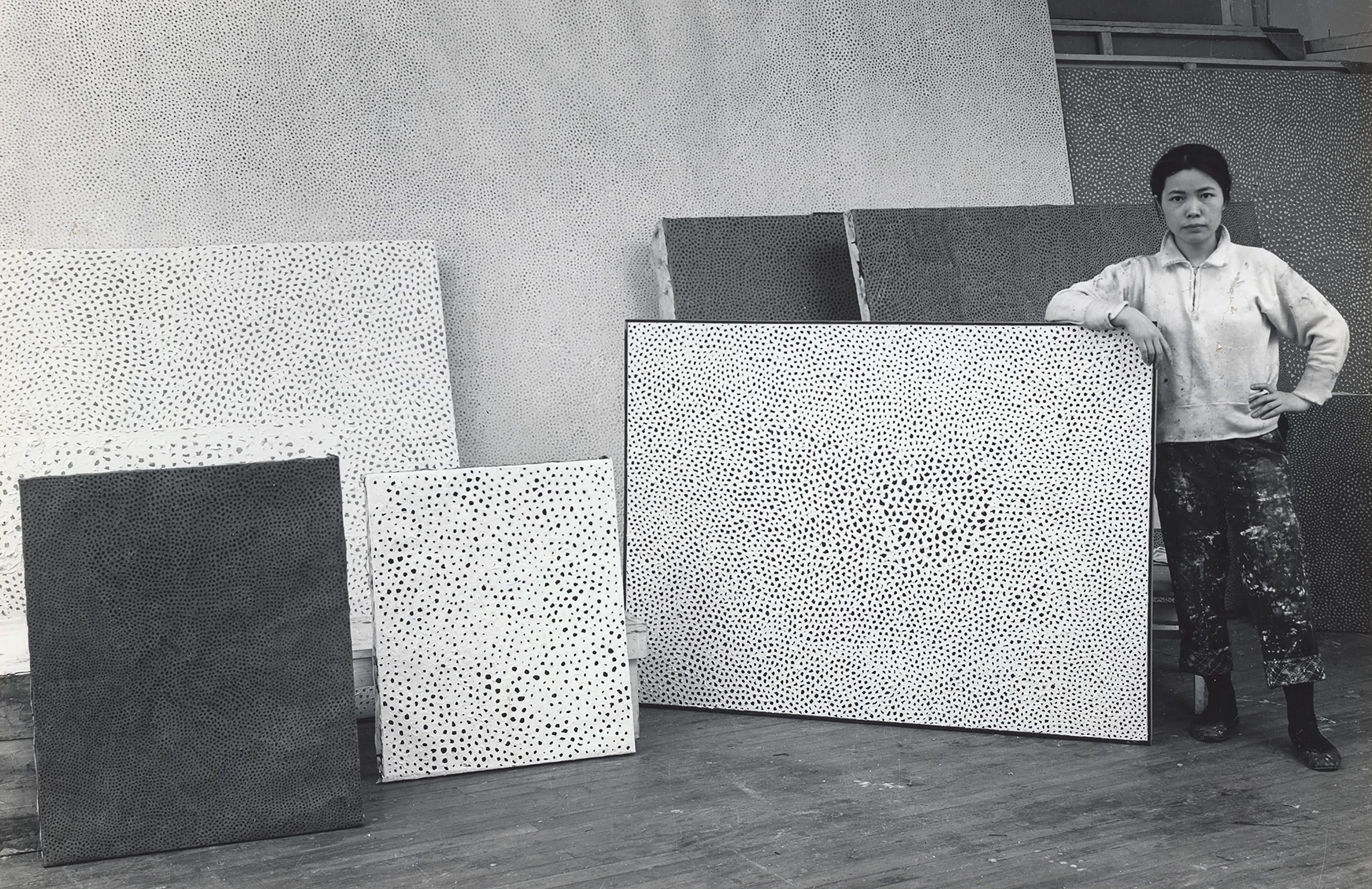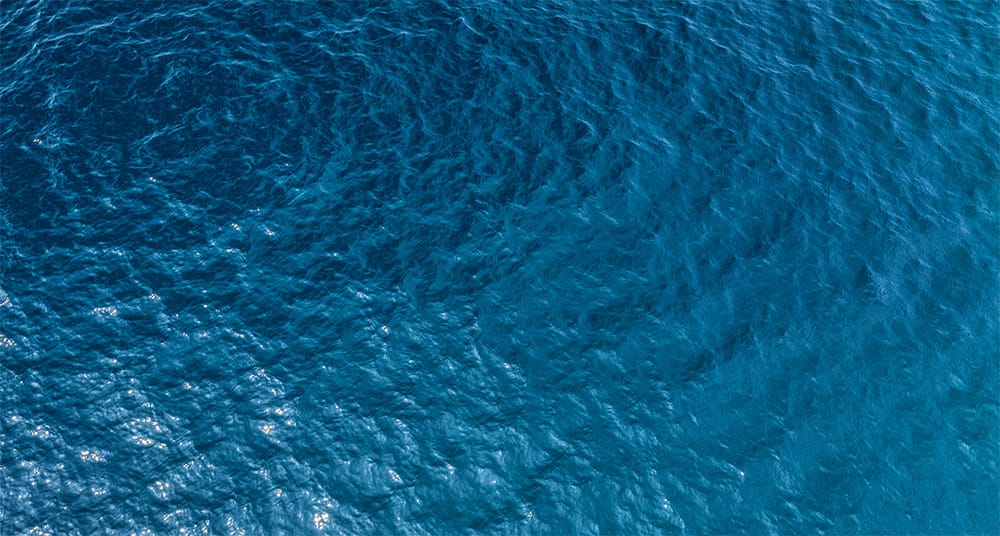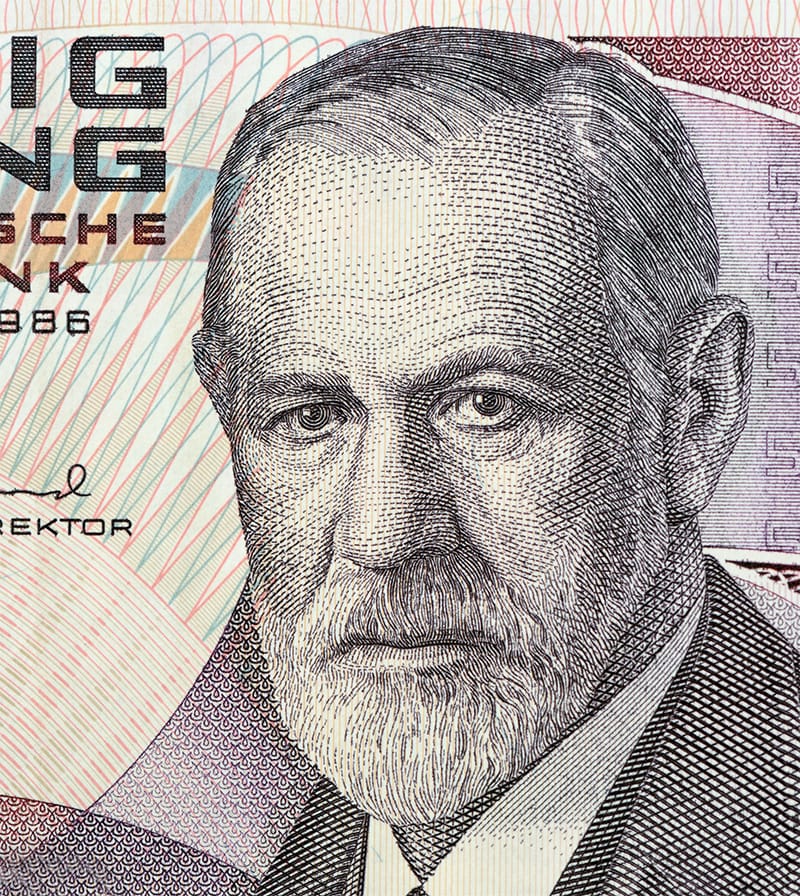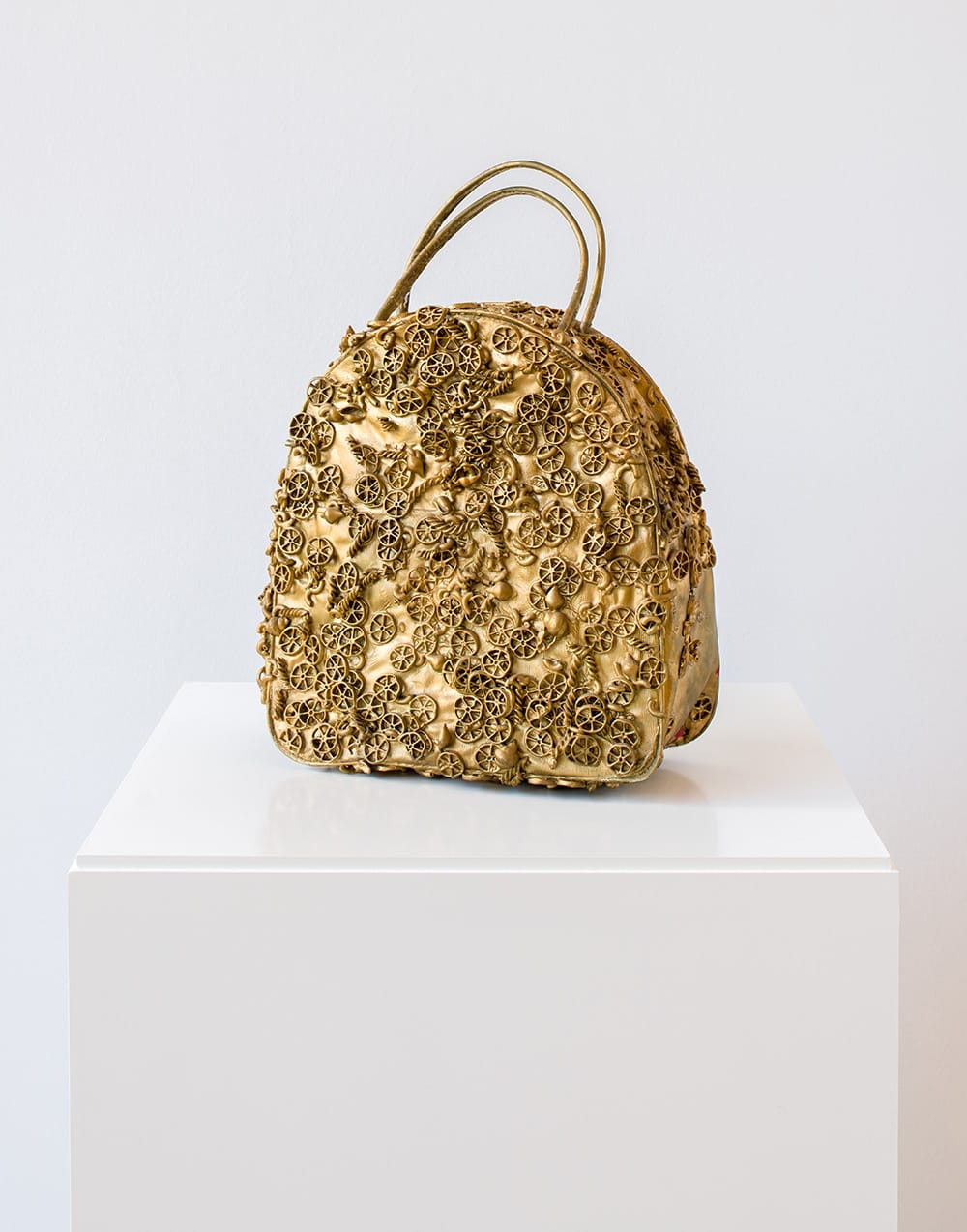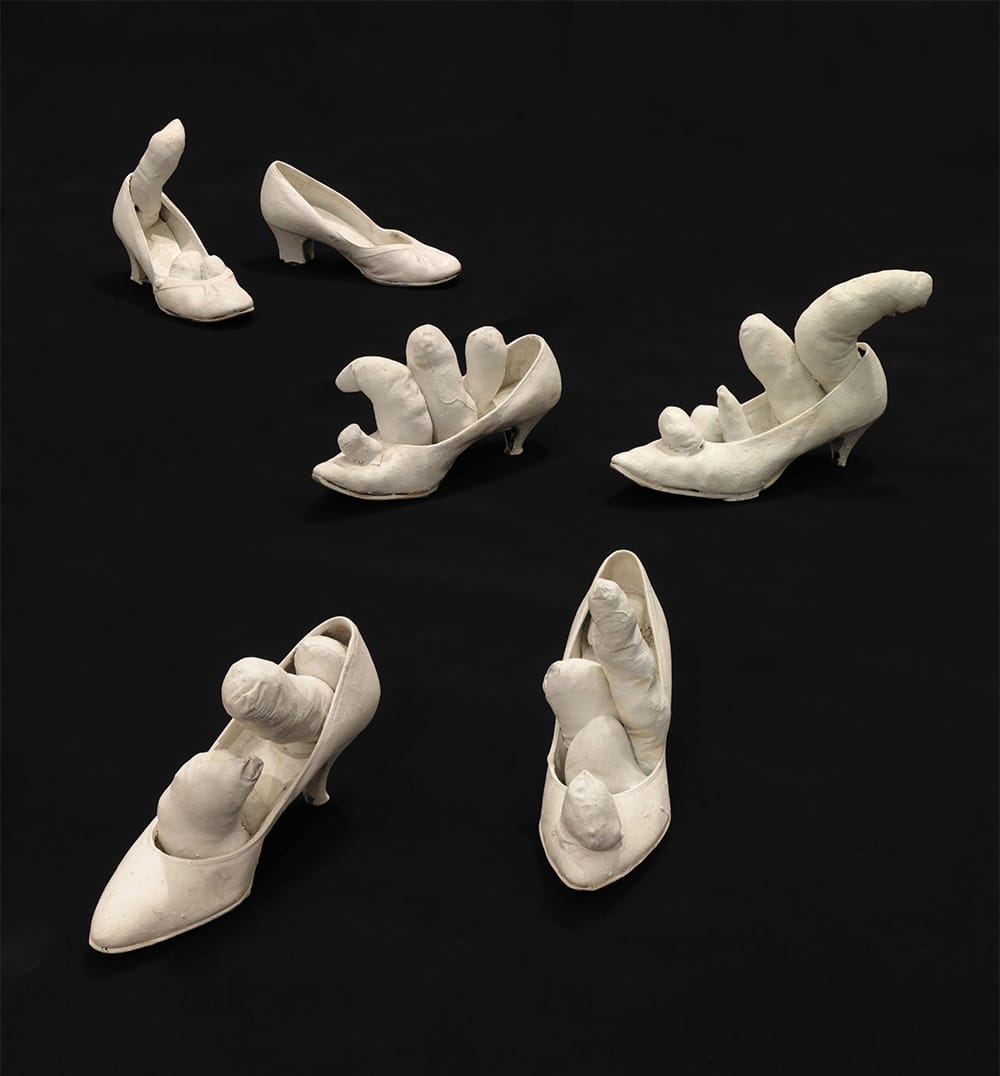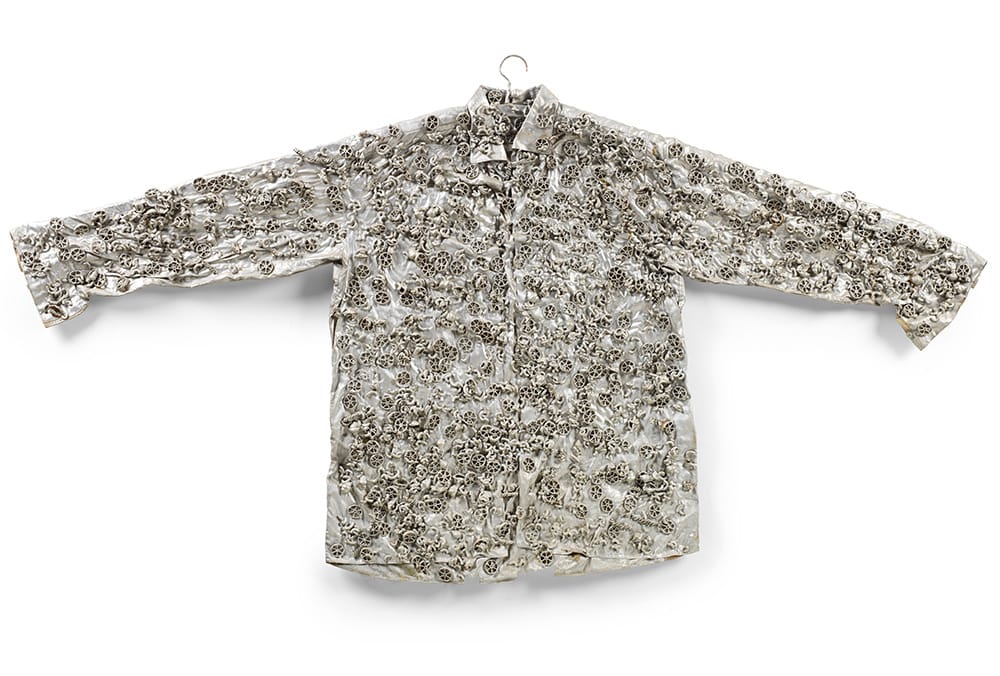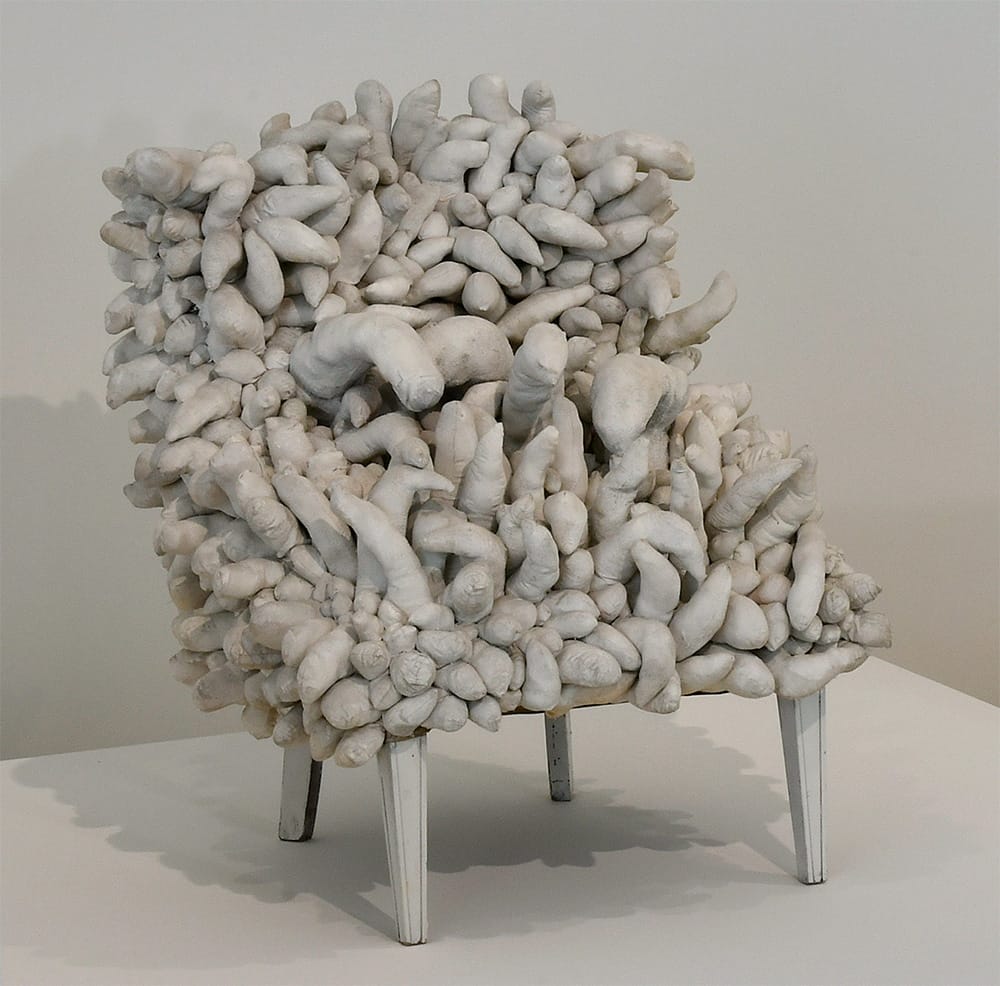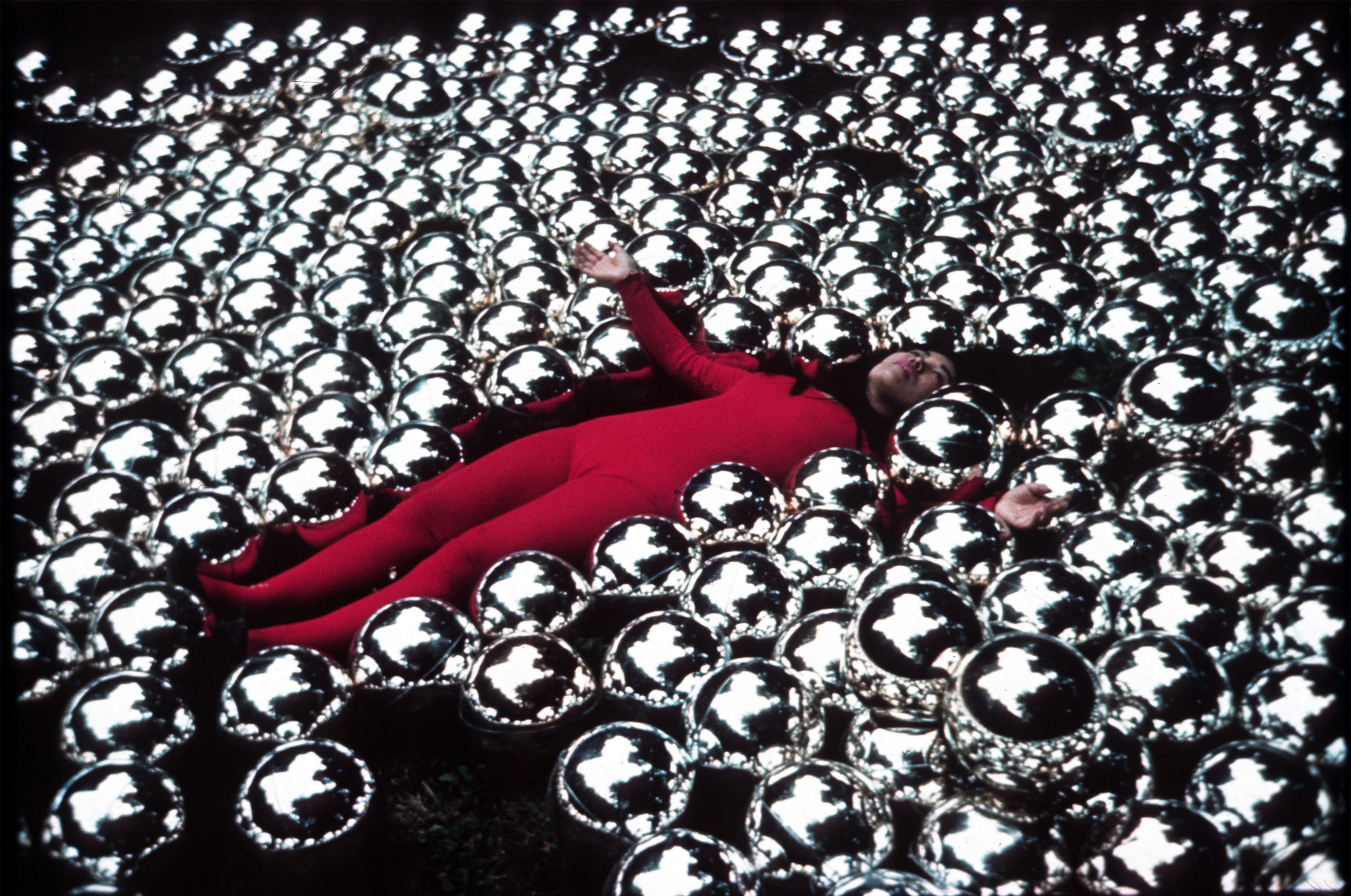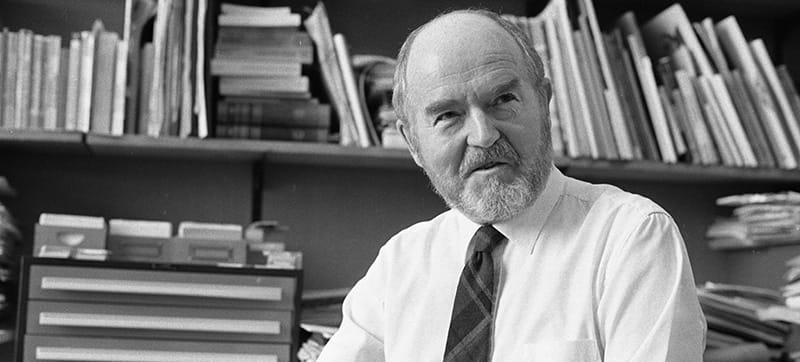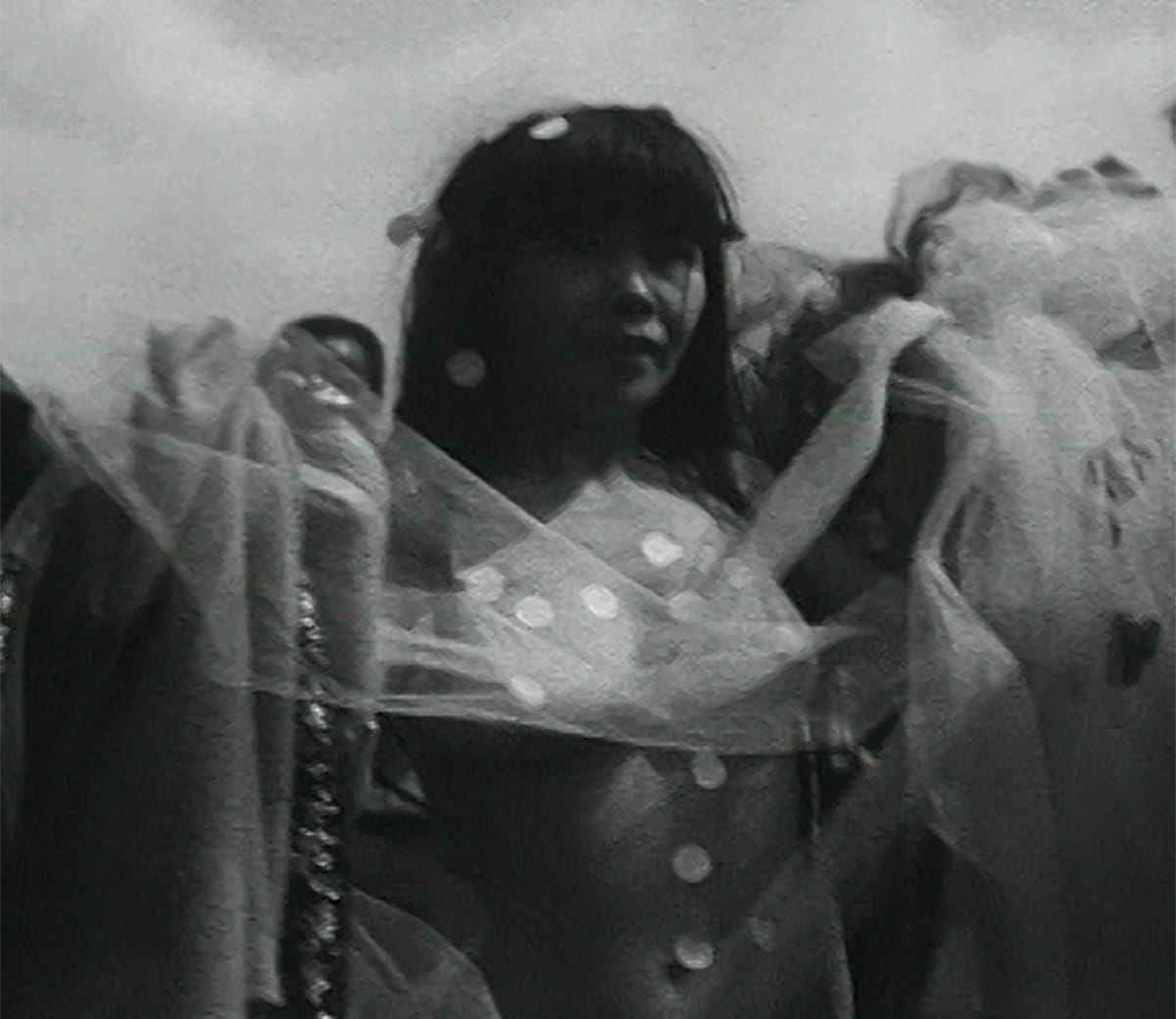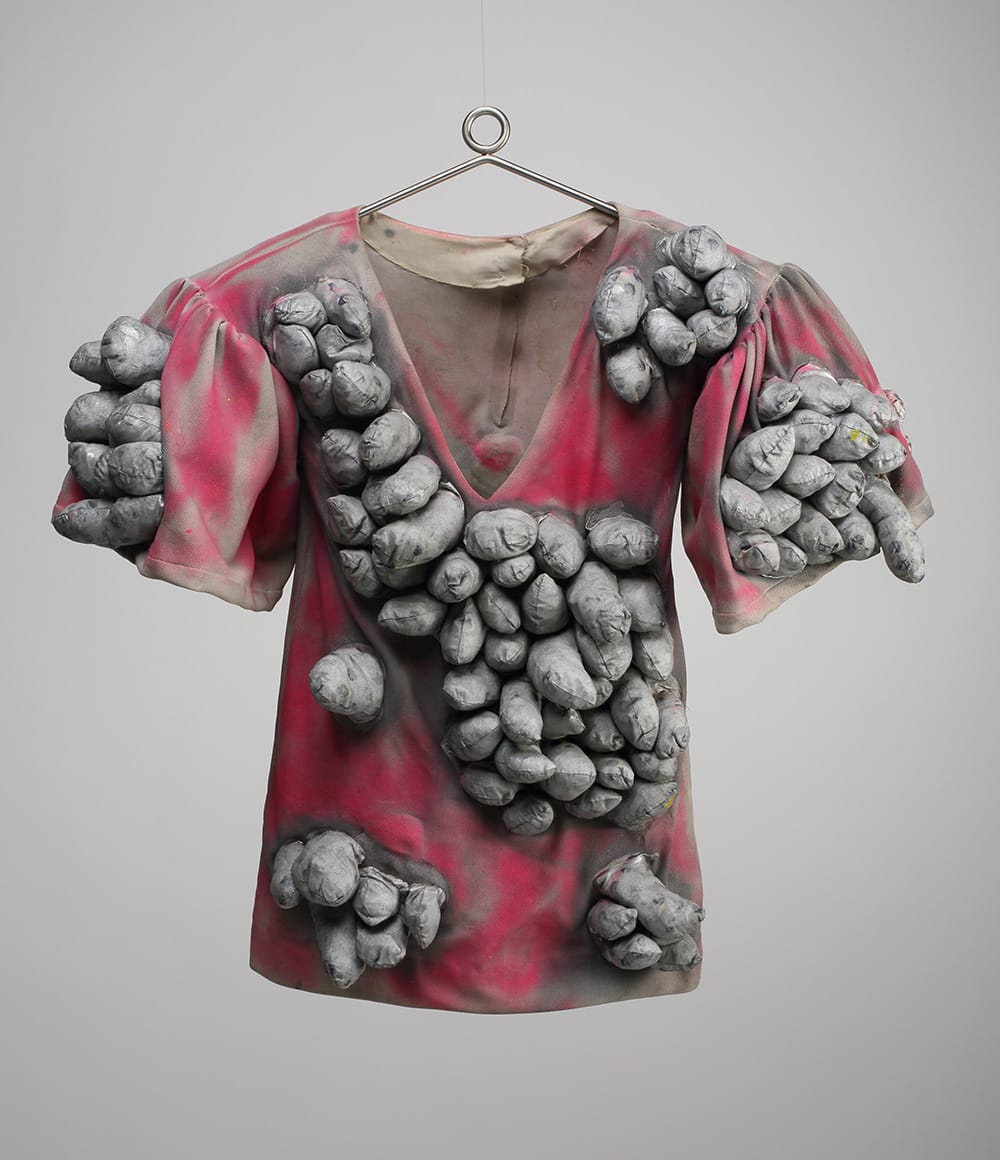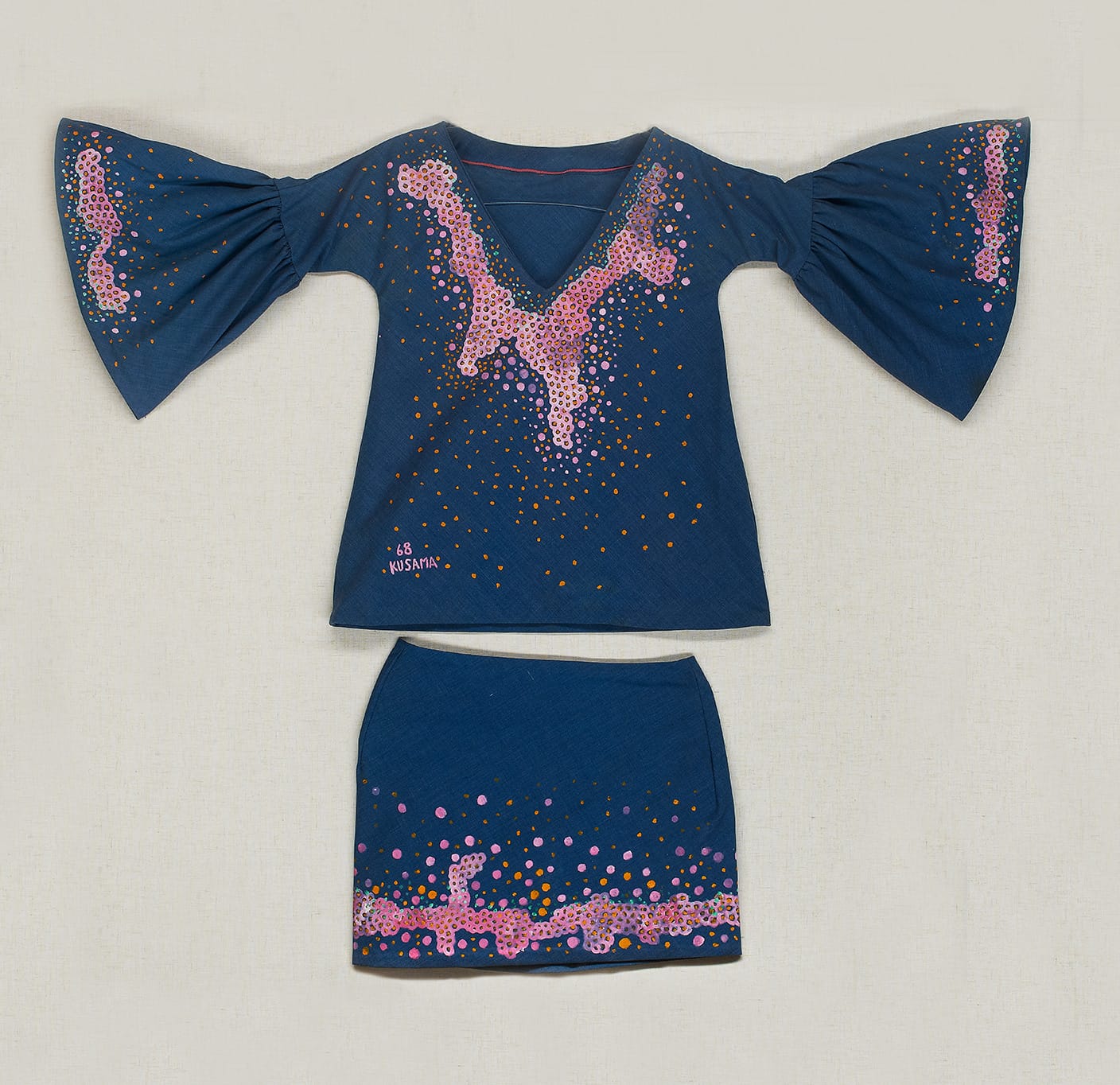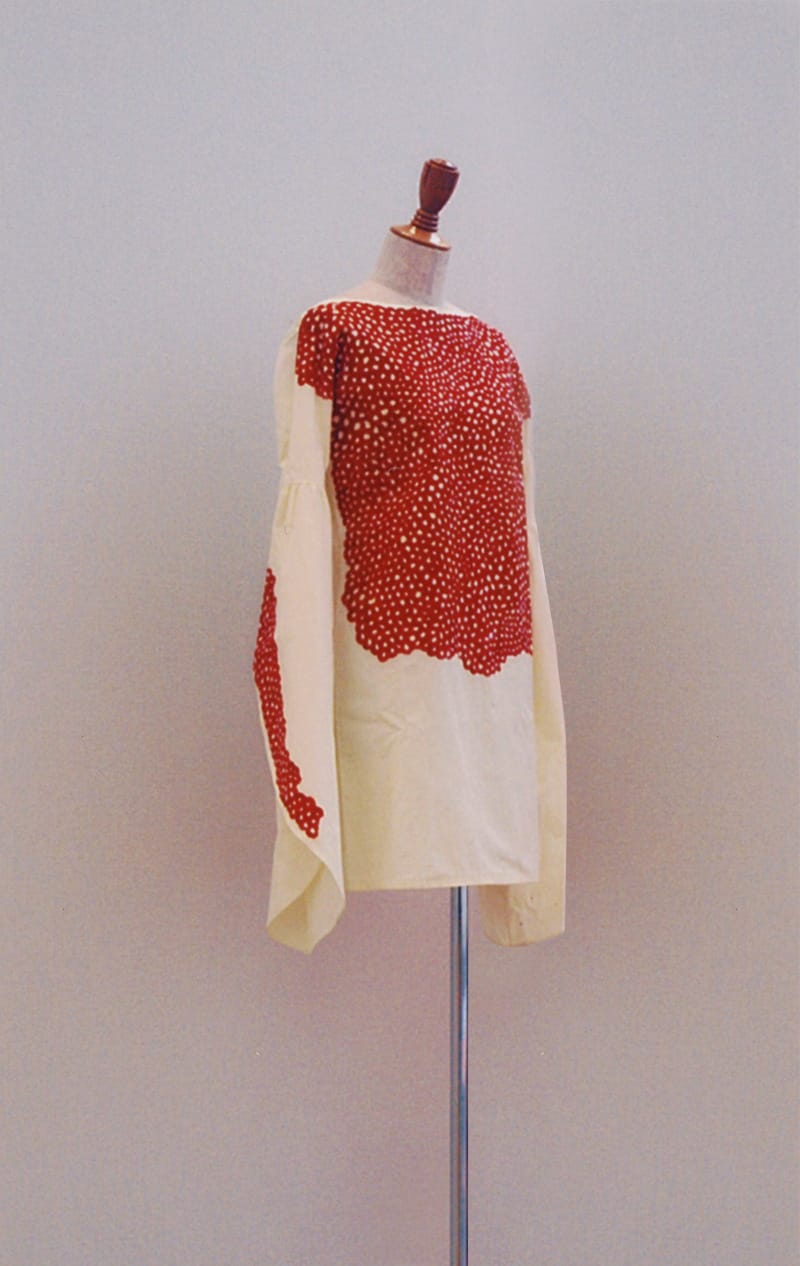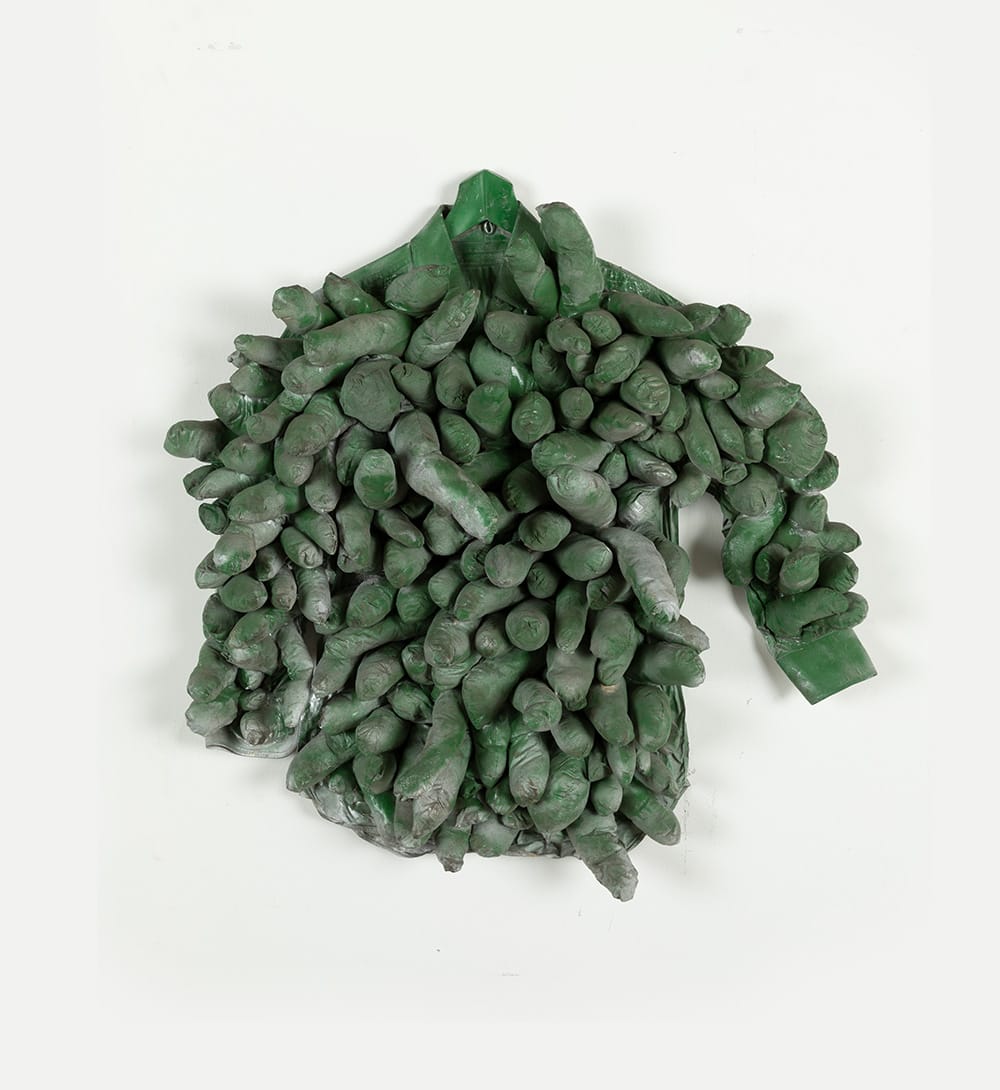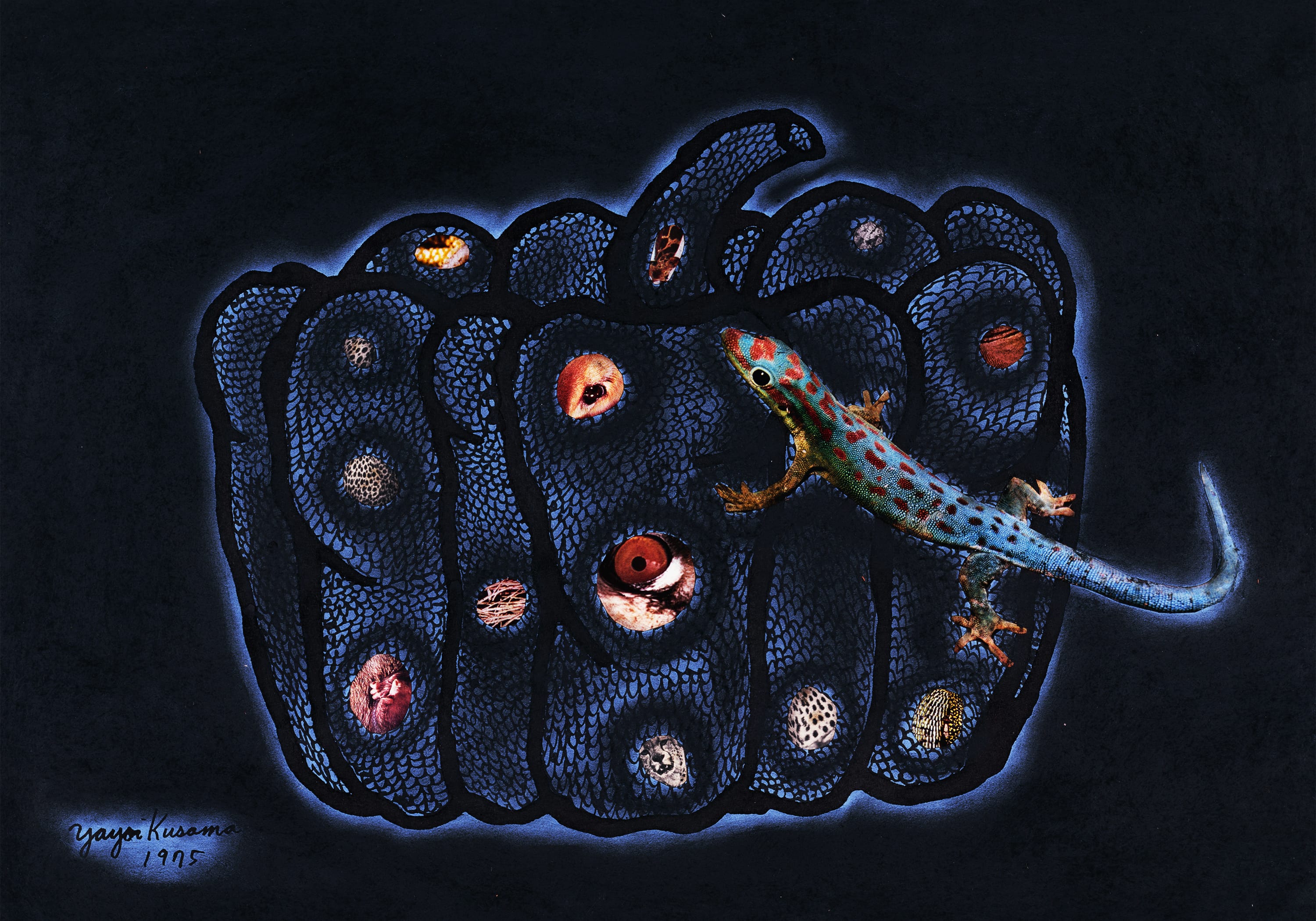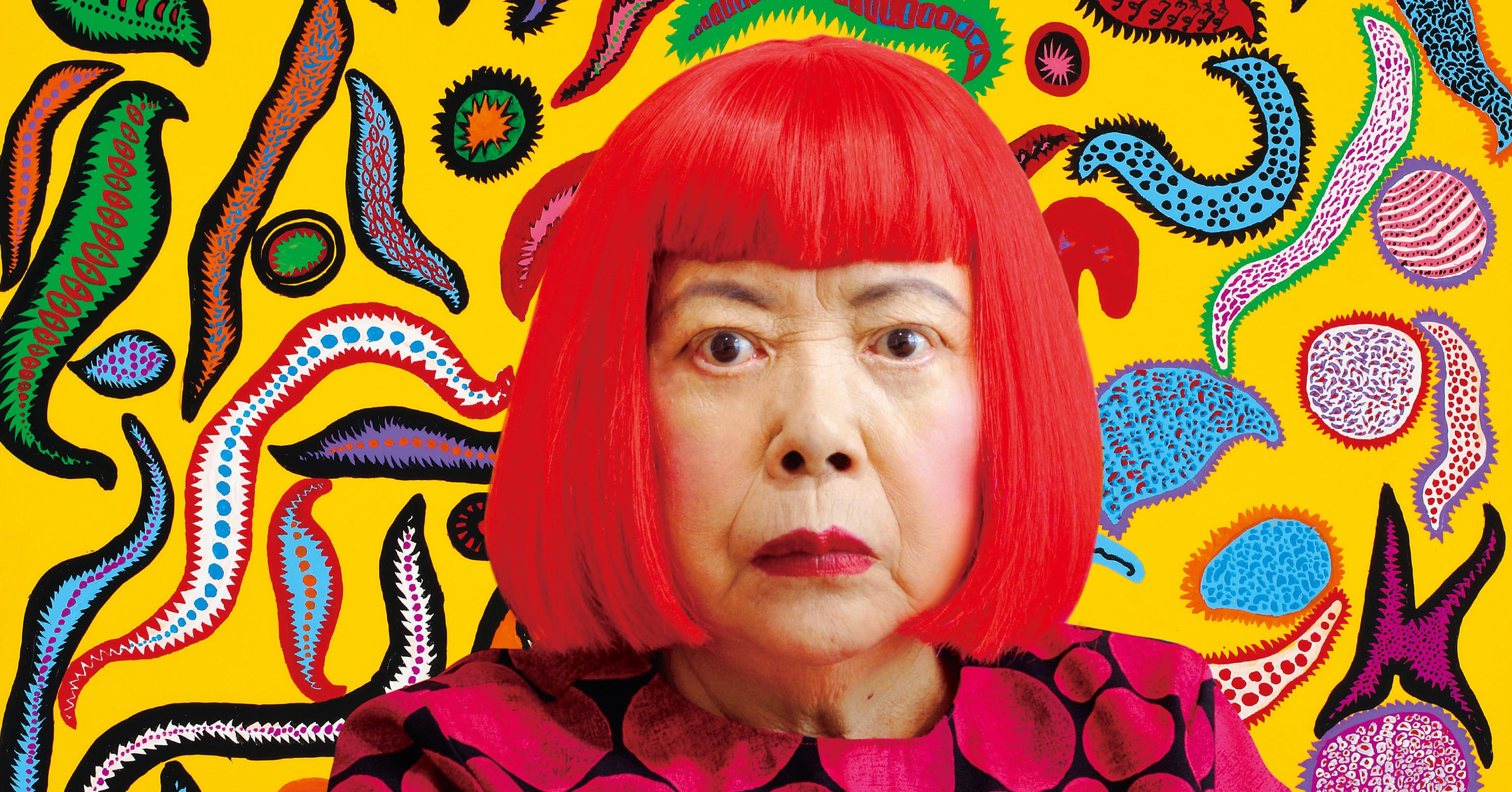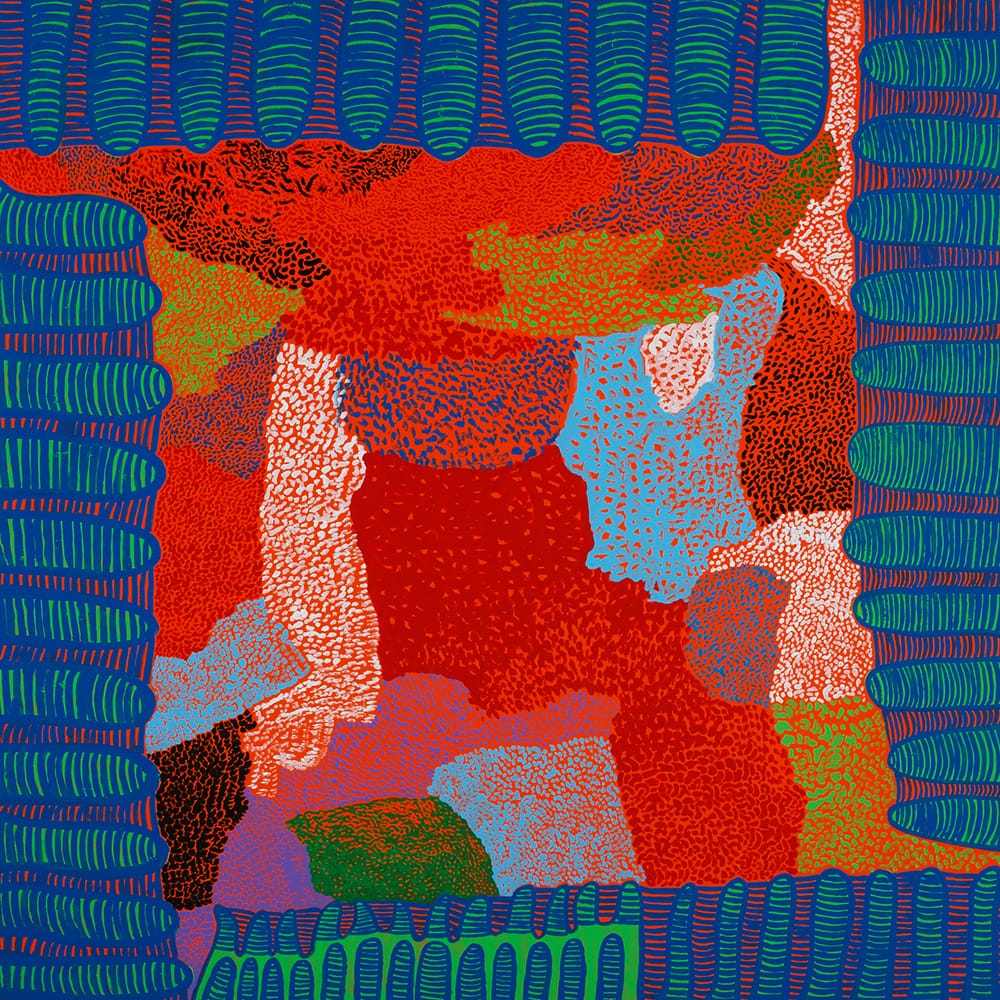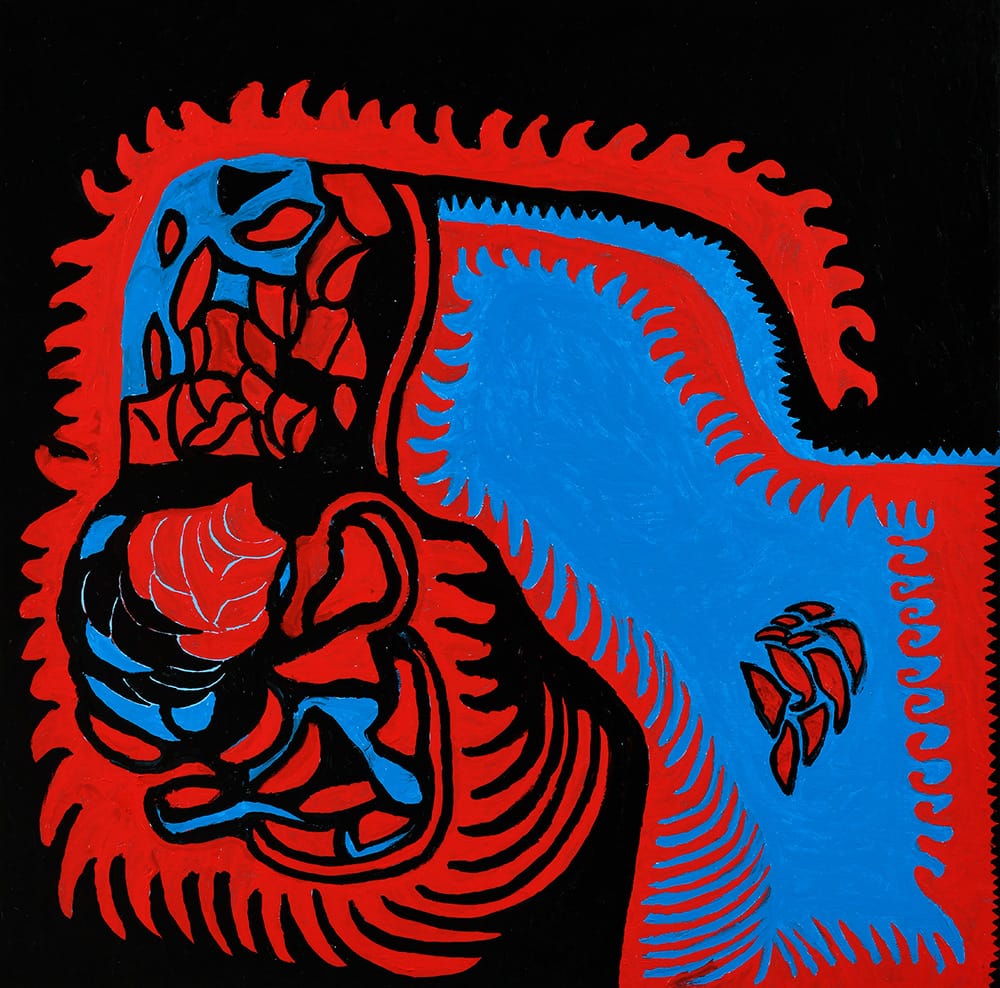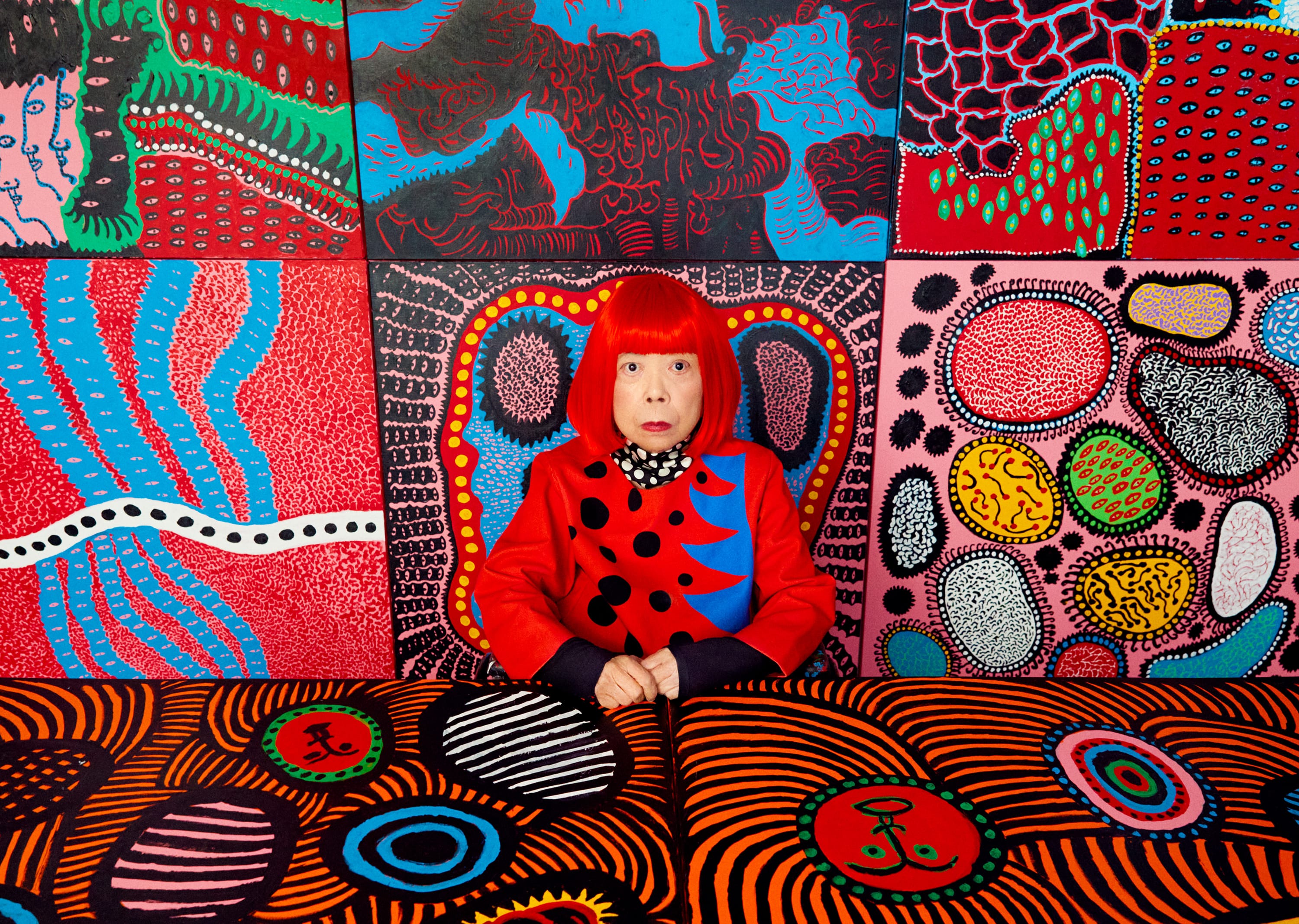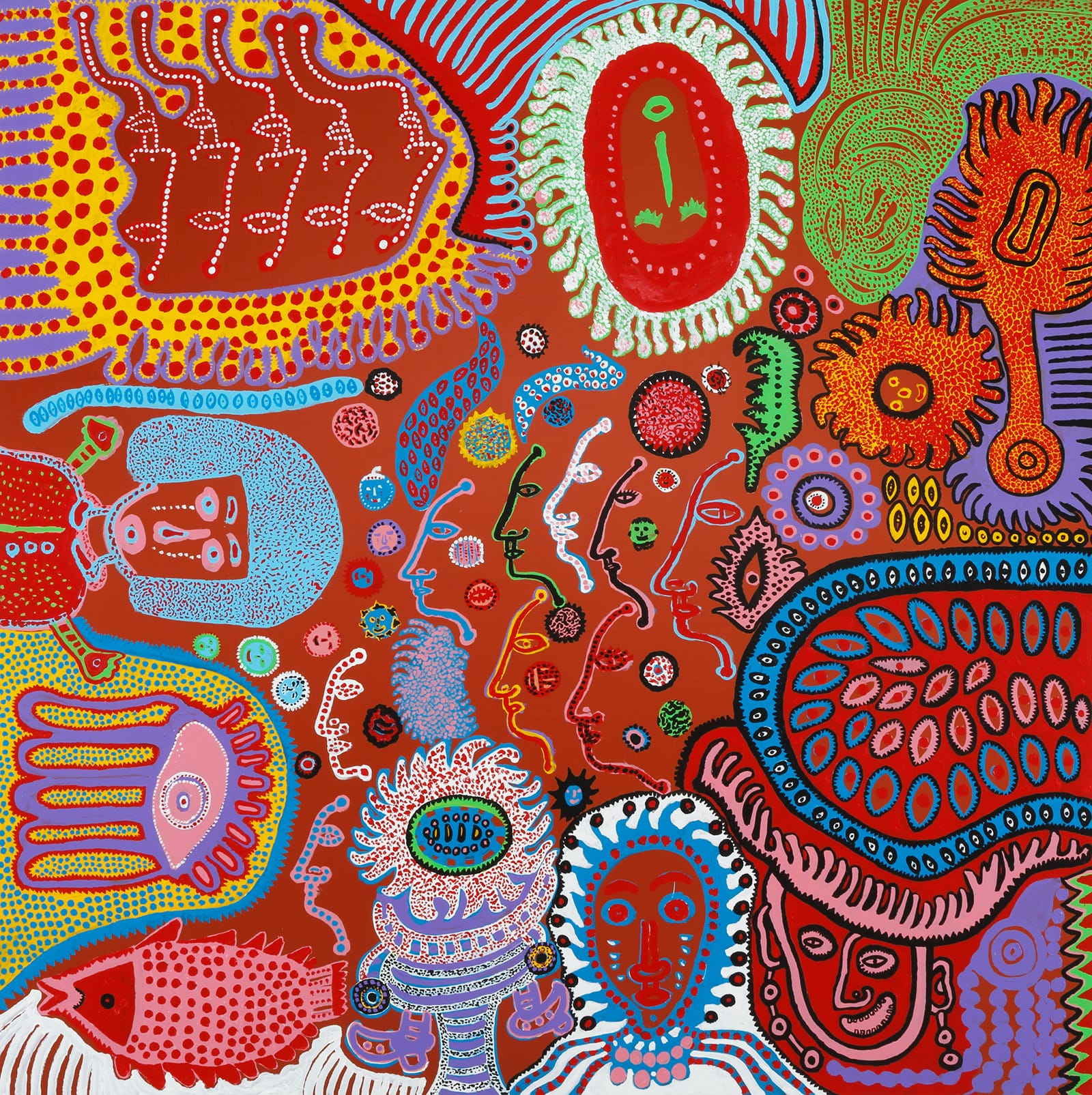
GIVE ME LOVE, 2015, from the series My Eternal Soul, 2009–ongoing, acrylic on canvas, 194 × 194 cm
Performer, provocateur, fashion designer, entrepreneur, exhibition maker?
The Japanese artist Yayoi Kusama (b. 1929) is all of these things – and much more. Art and life are inseparable in her work. The Gropius Bau highlights this diversity in the first survey exhibition of Yayoi Kusama in Germany. The importance of Europe as a place where she tirelessly develops and presents her work – which spans a period of over 80 years – comes into focus, as does the question: how do her world-famous artworks, including her Infinity Mirror Rooms, or her techniques, like using dotted patterns (polka dots), perform in the here and now?
To this day, Yayoi Kusama continues to stage her art and her body in new ways. She creates a situation for almost every work that expands into the viewer’s space. The exhibition and this Digital Guide give an impression of important works in their original spatial situations and their artistic and historical backgrounds. The circle closes with Kusama’s latest works – a journey into infinity.

Yayoi Kusama around the age of ten, c. 1939
Even if the work before me were to require four hundred years to complete, I would begin this very moment – that is how I feel.
– Yayoi Kusama: Infinity Net. The Autobiography of Yayoi Kusama, 2002
Japan Then & Now

Matsumoto
Yayoi Kusama is born in the spring of 1929 in the small town of Matsumoto, amidst the idyll of the snow-capped peaks of the Japanese Alps, a pebbly riverbed behind the house and colourful flower fields, which her family owns. A sketch pad and watercolours are her constant companions during early childhood. However, Japan at the time is a strict military-run society. Traditional values also shape Kusama’s affluent family – becoming an artist was therefore a struggle.

Accumulation of Corpses, 1950, oil on paper, 45.3 x 52.3 cm
Kusama’s first solo exhibition takes place in her hometown – her first success.
After studying traditional Japanese „Nihonga” painting in Kyoto, she shows over 200 small-format works on paper in Matsumoto in 1952. For this first show she already envisions a special mode of presentation. She attaches the drawings to fine threads and hangs them in front of thick dark brown fabric in two rows that surround the viewer. This unity of viewer, space and artwork is to become typical of the art of Yayoi Kusama.

Installation view of Kusama’s first solo show at the First Community Centre, Matsumoto, 1952
The danger is growing, isn’t it? / Just standing there inside the fragrance / Look – even on the ceiling and pillars
Excerpt from the poem “Violet Obsession”, in: Yayoi Kusama: Infinity Net. The Autobiography of Yayoi Kusama, 2002, p. 65
Georgia O’Keeffe
Though I feel I am so very far away from where you are and only on the first step of a long difficult life of a painter. I should like to ask if you would kindly show me the way to approach this life.
– Correspondence between Yayoi Kusama and Georgia O’Keeffe quoted in: Yayoi Kusama: Infinity Net. The Autobiography of Yayoi Kusama, 2002, p. 83

Accumulation of Globulars (No. B), 1962, oval paper stickers on paper, 62 × 74.5 cm
Infinity Nets
Kusama’s urge to break boundaries takes shape in the late-1950s. Thanks to a wide range of support – not least from the famous American painter, Georgia O’Keeffe – Kusama finally moves to New York, which becomes her new home. Infinity becomes Kusama’s artistic credo. In draughty studios she works day and night on large-format canvases, which she covers with tiny, detailed mesh patterns that increasingly also cover windows and chairs. Kusama’s characteristic Infinity Net Paintings are born. With them, she becomes the new star in the sky of the New York art world. At the same time, she desires nothing more for her (and her viewers) than to be completely absorbed in her works.

Dot Abstraction, 1958–1960, oil on canvas, 114 × 113 cm
My desire was to predict and measure the infinity of the unbounded universe, from my own position in it, with dots – an accumulation of particles forming the negative spaces in the net.
– Yayoi Kusama: Infinity Net. The Autobiography of Yayoi Kusama, 2002
Psychoanalysis


Photograph of Kusama’s Ten-Guests Table, 1963, black and white photography, 23.8 x 18.3 cm
The motif of the banquet table overflowing with phallic Accumulations is repeatedly taken up by Kusama, as here in Ten-Guests Table from 1963.

Exhibition poster, Aggregation: One Thousand Boats Show, Gallery Gertrude Stein, New York, 1963, 43.5 × 57.3 cm
At this time, Kusama often finds the objects and furniture for her works simply on the street, as in Aggregation Row Boat (1963). She covers the rowboat, which she takes from the streets of New York, with countless fabric phalli and thus constantly expands her Accumulations.
Aggregation: One Thousand Boats Show
Repetition does not always equal sameness. Kusama’s art seeks to push boundaries, moving from the canvas, which she paints from corner to corner with energetic detail, into spaces that are consumed by fabric shapes. Following the principle of repeating a single shape, Kusama’s Accumulations or Aggregations bring together a mass of everyday objects. She makes cotton-stuffed and fabric-sewn phalli, which populate a rowboat and furniture, glued macaroni cover mannequins and clothing. Kusama conceives of entire rooms, which are created to become so-called “environments”.
Aerospace

Kusama in her first Infinity Mirror Room – Phalli’s Field, Castellan Gallery, New York, 1965
Phalli’s Field
How can one imagine infinity, visualise it, even feel it? Kusama is obsessed with the challenge that the phenomenon of endlessness poses to the human imagination. One of the many ways in which to express this feeling artistically becomes particularly successful: Kusama’s mirror installations, namely, her Infinity Mirror Rooms.
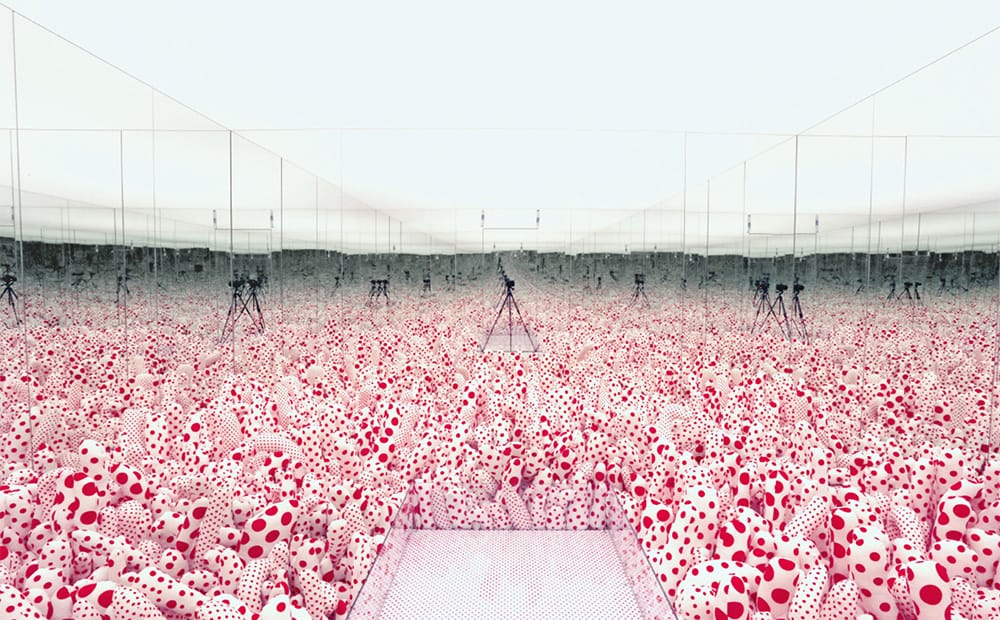
INFINITY MIRROR ROOM – PHALLI’S FIELD (OR FLOOR SHOW), 1965/2013, sewn stuffed fabric, wooden panel and mirror, 250 × 455 × 455 cm
In Kusama’s carefully constructed rooms, a kind of mirror cabinet, one’s own reflection is multiplied to infinity.
In these mirror rooms, Kusama places a large number of identical objects that are often shaped to look like organic forms. The objects are also covered with repeating patterns, such as the polka dots that have now become Kusama’s trademark. These dots cover all kinds of things (which later also include people’s bodies) seeking to unite them. Total union is also the motto of her Endless Love Show, which has two equal titles, the other being Kusama’s Peep Show. In this Infinity Mirror Room, Kusama further heightens the dizzying effect with music and lighting.
Our earth is like one little polka dot, among millions of other celestial bodies, one orb full of hatred and strife amid the peaceful, silent spheres. Let’s you and I change all that and make this world a new Garden of Eden…
– Excerpt from Yayoi Kusama: An Open Letter to My Hero, Richard M. Nixon, 1968, quoted from: Tatehata, Akira / Hoptman, Laura / Kultermann, Udo / Taft, Catherine: Yayoi Kusama. Revised and Expanded Edition, 2000, p. 103
Fontana

Kusama in her Installation Narcissus Garden at the 33rd Venice Biennial, Italy, 1966
At the same time, the photo shoots of the artist (which by now have become a professional component of every new work) gain precision: in addition to the carefully considered pose come specially designed costumes, including hairstyles and body painting. Kusama’s installations – her expansive, multimedia sculptures – are increasingly becoming performances – that is, scenic representations.
Venice, for example, the year 1966: parallel to the city’s highly reputable art biennial, Kusama presents (with permission granted by Biennale Committee, yet without official invitation) a work in which she performs wearing a shimmering kimono. She sells her own works in the form of 1,500 mirror balls, which are available for two US dollars each. The work is titled Narcissus Garden and was co-financed by the renowned artist Lucio Fontana (b. 1899; d. 1968) – who was a friend of Kusama’s. Referencing the myth of Narcissus, who prefers his own reflection to the love of others, Kusama criticises the vanity of the international art world. This becomes her international breakthrough.
Udo Kultermann

Installation view of Kusama’s Driving Image Show at Galerie M. E. Thelen, Essen, 1966
Driving Image Show
How were Kusama’s provocative actions and exhibitions received in Germany in the 1960s? They arrive in the period after the lost World War II, during the time of the Cold War between the systems of socialism and democracy. Germany is a country divided into two opposing states. All that seemed to be common was the search for new orientation. New York, which at that time was the centre of the international art world, becomes a point of reference in the drive for new cultural possibilities in West Germany. There, Kusama’s performances and happenings expand into large-scale festivals and connect with the international anti-war movements and youth cultures of the post-war generation.
West German artists, such as the Düsseldorf artist group ZERO (founded in 1958 by Heinz Mack and Otto Piene) show their works in New York and encounter Kusama’s art. She seems to share their search for a “Stunde Null” (Zero Hour) – which stands for the demolition of old artistic values in the spirit of new beginnings – by making moving light sculptures, for example.

Installation view of Kusama’s Driving Image Show at Galerie M. E. Thelen, Essen, 1966
Yayoi Kusama re-enchants our world. She bursts forth in refulgent fashion [...]. Now she has been reborn before our eyes as a great contemporary artist forging the sensibilities of a most unpredictable future.
– Felix Guattarii, quoted after: Yayoi Kusama: Infinity Net. The Autobiography of Yayoi Kusama, 2002, p. 141
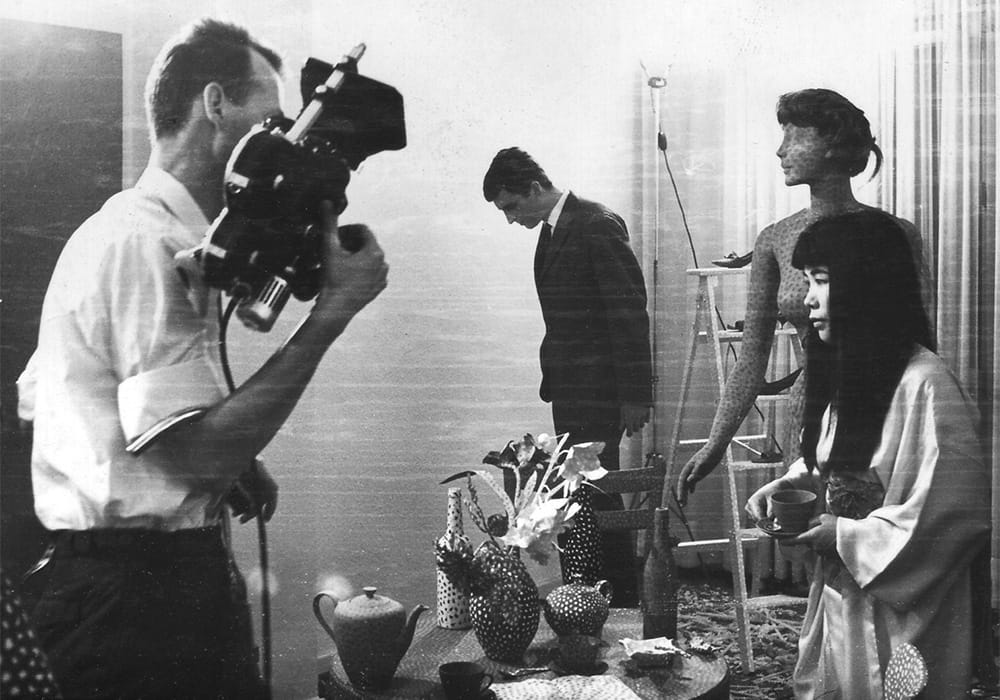
Kusama at the opening of her Driving Image Show at Galerie M. E. Thelen, Essen, 1966
Before Kusama flies across the Atlantic for the first time in 1965 for the opening of her first solo show in the Netherlands, she has already been involved in numerous group exhibitions in Europe – more than anywhere else at the time. The Internationale Galerij Orez in The Hague wants to represent her art. And Udo Kultermann has promised Kusama a solo exhibition in Germany. It opens in 1966 at the M. E. Thelen Gallery in Essen. There she presents a variation of her Driving Image Show, which travels from her primary New York gallery via Milan to Germany. It causes a stir in the press and even on television. This “show” is more than an exhibition. It is a central creative phase that revolves around obsessions with sex and food.

Polka Dot Love Room
Creating new realities – Yayoi Kusama thrives amidst the burgeoning form of performance art in the 1960s. In addition to one-off “happenings” during Kusama’s exhibition openings, there are body painting actions, which take place in public places. A troupe of young performers paints their naked bodies with Kusama’s signature colourful polka dots, as well as singing and dancing. Kusama’s orgy-like Body Festivals become internationally famous – and also notorious for police interventions.

The Hague, for example, the year 1967: in the fluorescent light of Kusama’s Polka Dot Love Room, naked people are painted with polka dots and mingle with polka-dotted mannequin sculptures. This is how Kusama not only breaks down the boundaries between different genres of art, but ultimately also the boundaries between performers and viewers. Without an active audience, this art doesn’t take place.
Make love, not war

Magazine cover KUSAMA orgy, Vol. 1, No. 1, November 1969, 42.9 × 28.9 cm
Kusama increasingly concentrates on the ever-demanding creation and implementation of new forms of expression.
Even the most elaborate photo shoots can no longer capture the special character of this art. Therefore, it is high time for Kusama’s first film, Kusama’s Self-Obliteration (1967). In order to organise and distribute her art, Kusama Enterprises is just one of several companies that the artist founds in 1968. A body-painting studio offers individual body painting and is also a modelling agency. In addition, she publishes the KUSAMA orgy magazine and organises orgy parties and posters. She also opens a fashion store on 6th Avenue in New York.

Happening and fashion show with Kusama’s Phalli’s Field as a backdrop, New York, 1968
The emperor’s new clothes: fashion becomes a new outlet for Kusama’s art, focusing on the importance of the body, or rather many bodies. They reveal the wearers’ skin so that they are partially naked. Kusama’s clothes thus represent the most important proponents of the sexual revolution and the liberation movements of the time: back to nature, away from mass-produced goods, the fight against convention and morality.
For her fashion label and her businesses, Kusama stages elaborate fashion shows on the rooftops of New York, as well as at her exhibitions in the Netherlands. There is a special feature that defines her clothing: the garments can often be worn by several people (up to 25 at once) and grant the necessary freedom of movement using funnel-shaped cuts, revealing body parts through circular cut-outs.
Even when you consider Kusama’s comparatively comfortable Pumpkin Pillows, which are often sold in museum shops today, Kusama’s fashion and soft objects are all about presence. Her art is not afraid of life and asks us to rethink how the most basic parts of society function.
If you reach your home town / decayed thorns of the rose balsam zinnia Chinese aster tears / Grind them to powder to burn of a rock / I stir the ashes of fragile flowers
– Excerpt from the poem Prisoner Surrounded by the Curtain of Depersonalization, quoted after: Yayoi Kusama: Infinity Net. The Autobiography of Yayoi Kusama, 2002, p. 91

A Nest of Life, 1975, collage, ink and pastel on paper 39.8 × 54.6 cm
Encounter of Souls
Manhattan Suicide Addict, the title of Kusama’s first novel (1978), goes straight to the heart of the exciting life lived by artists in the metropolis: fatigue sets in, a life beyond partying and business seems desirable.
In 1973 Kusama moves back to Japan and in 1977 into a psychiatric hospital in Tokyo – where the artist continues to live and work today. Even in this situation and despite health problems she finds ways of opening new areas for her art. Writing essays and novels becomes a creative retreat during a time in which the Japanese media heavily criticises Kusama’s art.

Self-Portrait, 1972, collage, ink, pastel and ballpoint pen on paper, 54.3 × 39.5 cm
I sing of a part of the shadow that lives hidden on earth, in which the whole thing appears incessantly. [...] I want to live in secret, in the world between mystery and symbol.
– Yayoi Kusama: Infinity Net. My autobiography, 2002


FLOWER PETAL, 1974, unfired clay and paint, 11.5 × 23.5 ×12.5 cm
Kusama fills wooden cupboards with fantastical objects like FLOWER PETAL (1974), spreads fabrics over staircases, shows glittering phallic shoes, as well as self-portrait photographs.

The End of Summer, 1980, installation of table with two chairs, variable dimensions
The familiar motif of the table also finds its place in Encounter of Souls. This table is consumed by fabric forms, as was the case with the Ten-Guests Table (1963) 20 years beforehand.
Over the years, Kusama develops a broad spectrum of art. The exhibition Encounter of Souls (1983) at Jardin de Luseine in Tokyo is all encompassing. The entire Art Nouveau interior of the building, which serves as an alternative exhibition space, becomes a canvas for her colourful objects, floor works, paintings and ceramics. In 1983, the exhibition Encounter of Souls at the Jardin de Luseine in Tokyo shows how Kusama’s diverse art forms, developed an amassed over the years, come together to form a total work of art. The project is the height of Kusama’s all-encompassing artistic aspirations: instead of constructed new spaces, as she has made previously, here she fills old things with new life to create her own Kusama world. The entire interior serves as a tableaux for her colourful objects, as well as floor works, paintings, ceramics and much more. A work by her old friend, the US- American painter Joseph Cornell (b. 1903; d. 1972), is also on display. Kusama organises a happening with the now world-famous Japanese photographer Shigeo Anzai (b. 1939). The show is like her personal retrospective. It takes place only a few years before her first survey show in New York (1989), which is followed by international recognition of her work by major museums all around the world.

Yayoi Kusama Museum in Tokyo, opened in 2017
Kusama-World
1989 brings a turning point in Germany and the world. For Yayoi Kusama, this is the year of her first retrospective at the Center for International Contemporary Arts in New York – still the centre of the international art world. Such recognition triggers what could be described as “Kusamania”. In 1993, Kusama officially represents Japan at the 45th Venice Biennial, a good quarter of a century after her self-organised performance there. The Millennium brings the citizens of Matsumoto a retrospective of Kusama’s work in their municipal museum – a home win, followed by travelling exhibitions around the globe. And finally: her own Yayoi Kusama Museum in Tokyo in 2017.
Even the demi-monde of high fashion now embraces Kusama. Industry giants such as Issey Miyake, Comme des Garçons and Louis Vuitton organise extensive collaborations with her.

THE SPIRITS OF THE PUMPKINS DESCENDED INTO THE HEAVENS, 2015, mixed media 200 × 200 × 200 cm
„Kusama created immersive, destabilising environments that expanded into entire buildings, creating a dizzying hypnotic feeling to realise her own ‘Kusama-World’ – one that envelopes the bodies of one and all.”
Stephanie Rosenthal, Director Gropius Bau
Honours
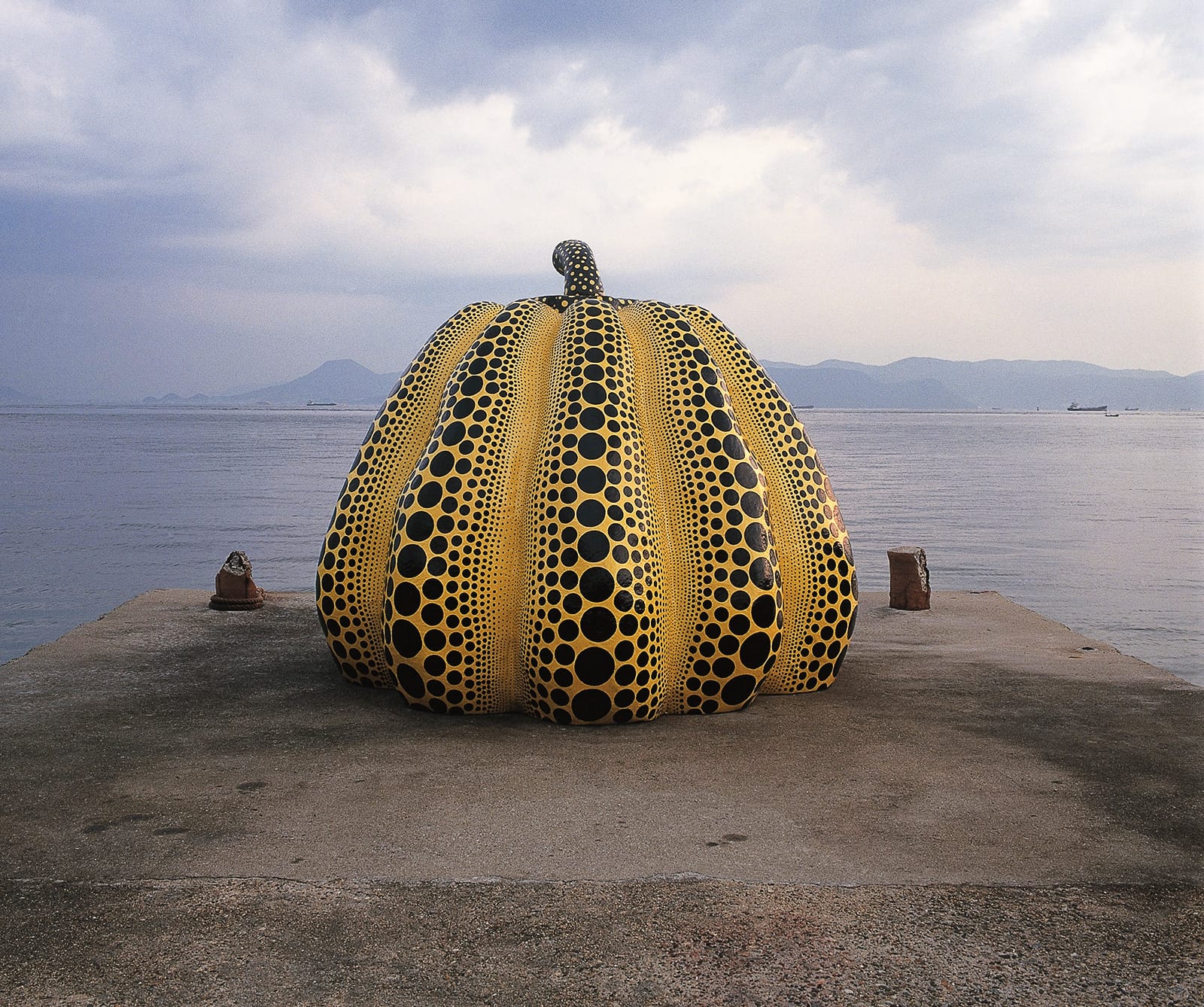
Pumpkin, Benesse Art Site, Naoshima, Japan, 1994
In the last two decades of Kusama’s work, a motif emerges that is more likely to be found at eerie Halloween festivals: the pumpkin.
Kusama’s interest in the pumpkin motif goes back to an eerie early childhood memory when she has her first hallucination, but also a positive connection with nature. Living once again in Japan, Kusama reflects on figurative motifs in her painting, such as eyes. However, her abstract work blooms anew and the pumpkin becomes an important new pattern within Kusama’s dotted, garish-coloured installations.
Pumpkins could be experienced, for example, in the room titled Mirror Room (Pumpkin) Room in the Japanese Pavilion at the Venice Biennial or, indeed, in public spaces such as the Place Vendôme in Paris (2019). Both invited the viewer to join the dance of self-abandonment and self-renewal in the art of Yayoi Kusama.

Since the beginning of the 2000s, Kusama’s work is marked by another return: painting.
Recalling her early drawings, Kusama focuses once again on two-dimensional motifs. The square painting series My Eternal Soul (since 2009), for example, remains unfinished to this day. Here too, Kusama seeks an effect that encloses and surrounds the viewer. She exhibits her latest paintings so that they completely cover the walls. As such, the circle of Kusama’s world closes in a seemingly infinite space of colour and movement.

EVERY DAY I PRAY FOR LOVE, 2019, from the series My Eternal Soul, 2009–ongoing, acrylic on canvas, 100 x 100 cm
I often cannot sleep at night because I am so driven by the desire to make art that defies all odds.
– Yayoi Kusama: Infinity Net. My Autobiography, 2002
